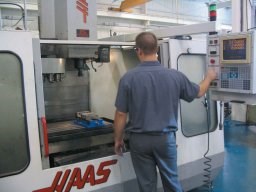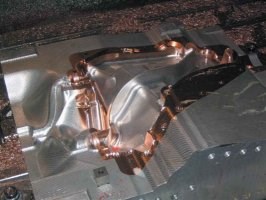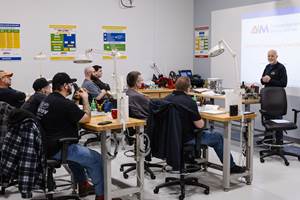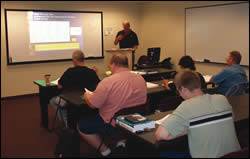Terra Community College: Moving Forward in Leaps and Bounds
Moldmaking students get hands-on training from a community college's manufacturing apprenticeship program.
Nestled in Fremont, OH, Terra Community College has a unique approach to getting students involved in the manufacturing industry. Offering specialized apprenticeship programs, students initially go through a set of classes tailor-made for their individual interest, preparing them for the apprenticeship program ranging in a number of specialties including moldmaking, machining and tool and die making.
Ohio's First Technical Colleges
A staple in the community for thirty-five years, the school has a rich history in the manufacturing industry. The apprenticeship program started in 1968 as part of a joint vocational high school. The original technical colleges in Ohio grew out of two-year vocational high schools; the colleges would use the high schools' facilities in the evening. Within two years, the programs grew large enough that day and night classes were needed. The technical college system was spawned under former Governor James A. Rhodes. Emphasizing the need for technical and vocational training at the high school and post-high school levels, a constitutional amendment approved by the voters in November, 1968 provided for the issuance of $779,000,000 worth of bonds, including $100,000,000 for vocational, technical and higher education and juvenile rehabilitation (www.ohiohistory.org).
Funding came from other sources as well. In addition to the state of Ohio's funding from Governor Rhodes, the U.S. government funded vocational education under an act that was part of the defense department; the act grew out of a lack of machining for WWII and Korea. The government needed machinists for the aircraft and armament industry. Eighty percent of Terra's equipment was paid for with federal money, as was the hiring of instructors and creation of facilities. Finally, there was funding through tuition and fees received from the students.
At that time, there were seventeen colleges that began to service the community and industry. The initial objectives were to provide trained personnel for the industry, either entering or ongoing. Terra's apprenticeship program started within two years after the college opened. Technical classes were picked from industry demand, and the program started with classes in welding, electrical and manufacturing processes, which was known then as machining and tool and die.
Present Funding
Terra's funding today comes from different sources. Considering that the government's views of manufacturing have changed dramatically, the college only receives a small amount of vocational money through the tech prep component, provided by the Perkins Act (see Carl D. Perkins Vocational and Technical Education Act of 1998 Table at the end of this article.). It is a program that is available in all fifty states, mandated by the federal government to provide technical training at the high schools that are above the vocational skill level for advanced technical programs. "Our students in tech prep study CAD and CAD/CAM and they also get into robotics," explains Tom Kissell, Dean of Engineering and Industrial Technologies, "so it's a higher level of learning than just vocational training." Receiving about $100,000 a year from the state government under capital equipment, they also receive about $20,000 to $30,000 from the Perkins Act. The remaining funding come from tuition, lab and other fees.
Two years ago, Terra collaborated with area industries and applied for a Society of Manufacturing Engineers' (SME) Education Foundation grant (see SME Education Foundation Table at the end of this article.). Choosing three to five technical programs per year to receive a grant, Terra was one of the first community colleges selected for its program. Until last year, SME had not chosen a community college for its grant, recognizing instead larger engineering universities as California Polytechnic State University (San Luis Obispo, CA), Perdue University (West Lafayette, IN) and the University of Michigan (Ann Arbor, MI). It was a breakthrough for the college because not only did the grant award $160,000, but area industries matched that amount for another $180,000.
Apprenticeship Program
Amy Below, apprenticeship program coordinator, initially meets with area industries and companies to establish programs to meet its needs. "Depending on what the company requires in its trade, we'll set up the program," says Below. The program is broken down into five parts: engineering design, CAD-segment-CAD specialist, industrial maintenance, machining and metalworking and manufacturing technician. In addition to those five is the quality sector, in which students are learning from both the front end (blueprint reading) and the back end to quality analysis and statistics.
Offering both day and night classes, Below welcomes those wanting to come into the manufacturing degree or certificate programs by finding out in which program they are interested. Then, she enrolls them in the basic technical courses that apply toward their individual program, while coordinating their educational hours with specific companies to get the students into the apprenticeship portion of the program, meeting both companies' and the students' needs. If the company is a state-registered program with the U.S. Deparment of Labor, upon completion of their hours, students receive their journeyman's card.
For example, the moldmaking program, classified under Machining and Metalworking, include basic classes in applied math, blueprint reading, an introduction to CAD, metallurgy, machining processes, CNC machining and computer fundamentals to help with CAD and AUTOCAD. There also are the core classes, which include courses on blow molding and mold design that are used as a basis for the moldmaking apprentices to help them understand the fundamentals of mold building. Hiring students as entry-level apprentices, Mark Wendt of Fremont Plastic Molds, a blow moldmaking and blow molding company located in Fremont, OH, will start students on classes right away as well as put them on the floor, so he can get them used to the mold building process.
"We basically just convey our needs to the college and along with what we have set up with our standards with the U.S. Department of Labor, Terra works very well accommodating us with the classes we require," says Wendt. Typically, apprentices have four to five years to complete their educational requirements. They also have a state and U.S. Department of Labor minimum of 576 contact hours. Depending on how the technical programs are classified, most of them are between six hundred to one thousand hours.
In addition to Fremont Plastic Molds, other companies involved with the apprenticeship programs are Toledo Mold and Die (Toledo, OH) and Century Die Company (Fremont, OH),-both blow moldmaking companies-and subsidiaries of larger companies such as General Motors Delphi (Troy, MI), Lear Corporation (Southfield, MI), Honeywell (Morristown, NJ) and Whirlpool (Benton Harbor, MI). Overall, Terra has serviced more than one hundred companies in the Ohio area for more than thirty years. Although it is one of the smallest schools in the state, surrounded by big colleges and universities, it works quarterly with about fifty companies by providing the apprenticeship program for its needs.
Program Goals
Working with the manufacturing grant that they received from SME, Kissell and Below are aiming to make a change in the curriculum. The grant allows them to add a year-long capstone project for the students-these are projects where the students will team up with a certain industry to design and complete a project: the first quarter to design, the second quarter to build and the third quarter to analyze. This capstone will allow instructors to bring projects into a college and then let students see not only that what they're learning goes toward a project, but that other areas of manufacturing go into the same project. Bringing in written and oral communication skills to put together a technical presentation using Powerpoint and other software, students work together in teams to complete this project. "Many times companies are so small that everyone gets involved in the sales aspect when they are pitching a contract. With this project, our students will be learning to do these kinds of things-make short presentations and write and edit technically on procedures," says Kissell.
This capstone project differs from Terra's traditional apprenticeships because not only does it bring job applications into the classroom, but students learn to work together in teams, applying their projects to the part of manufacturing industry they are interested in and, at the same time, allowing them to see how all of manufacturing intertwines. In addition, it teaches them how to develop written, oral and presentation skills whereas the apprenticeship is strictly hands-on, real-world, on-the-job training.
Even though Kissel says that this new capstone project is a strange concept from where the program stands now, he thinks that the best thing about it is how Terra is growing to meet and work hand-in-hand with area industries. Meeting quarterly with more than twenty industries, Below and Kissell are trying to include as many companies as they can in this project by asking them what they need rather than go to companies and tell them "this is what the college has for you."
Keeping up with technology is another important priority for Terra. CAD/CAM capability is now in all areas of manufacturing. It is a constant fight for school programs to keep up with technology because every two to three years the technology evolves again. "Keeping up with the latest version of the software is a nightmare for me," says Kissell, "right now we run full versions of AUTOCAD, including the animation and inventor series, which gets into solid modeling. We also have Unigraphics software all the way through Mold Flow."
Terra instructors also go out into the industry and teach the same classroom courses on the factory floor allowing them to keep their fingers in the industry while making industry connections so they can design their courses based on the newest technology available. Terra has four full-time instructors in engineering design, CAD/CAM, CAD and a machine shop supervisor. The school also employs four to five part-time instructors who come from a factory environment. Companies will hire them to teach workers the latest classroom courses, such as CAD/CAM design. It also gets the instructors who have previously worked in the field back out into the industry. This is usually done in the summer and on their breaks, allowing them to add to their base salary.
Reaching Out
"For the last five years Ohio basically put its efforts into information technology (IT)-computer segments-in both the schools and the funding of new research and grants, and wrote off manufacturing. I think they are just finally realizing that manufacturing is still here and it's going to be here, and if they want to be a player in it, they will have to figure out ways to support it within the school systems," Kissell says.
Terra reaches out to area high schools to teach students that there are other options after high school than just college. Below and Kissell visit the high schools and explain to students that they can pursue the technical route as part of their regular workload while staying active in sports and extracurricular activities, ending with a combination of courses from their technical center. Below and Kissell bring all freshmen and sophomores to Terra's campus as part of the tech prep program to show them how the program works. Then, as juniors and seniors, interested students go through the tech prep program. This recruitment process is changing the face of traditional conventions, bringing more students back to careers in technology while at the same time bringing technology back into the high schools. Right now, area high schools' tech prep programs have about 140 students in manufacturing; of those, forty students that graduated came into Terra's manufacturing program as full-time students.
Kissell and Below also are working on a career day for nontraditional areas geared for young women and high school students, slated for the spring. They also are looking at coordinating an apprenticeship conference at Terra in which part of that will include recruitment and collaboration with minorities next fall.
Finally, Terra hosts a children's college in the summer with children ranging from ages four to fourteen. These children participate in all kinds of technical activities through which they are introduced to technology. "There is a wide variety of activities; students can come and take computer courses, that lasts two segments of one week each," explains Kissell.
Role Models
And as for advice for other schools on implementing this type of program? Kissell says, "I think the biggest thing that we've found is to reach out and try contacting as many industries as you can through an apprenticeship coordinator, who will go out and actually visit companies, sit down with them, explain the apprenticeship process and then help them. Amy goes out, sits right at the company desk and signs up people so they don't have to stop and come in to us." He also says colleges need to involve as many companies as possible on the advisory process and keep those important links between the industry and the colleges.
Live instructors also are an important part of the learning process. Even though some colleges are going to a CD-ROM-based learning environment for some of their apprentice programs, Below is not a believer in the efficiency of that teaching method. Kissell agrees, "We think that hands-on learning is an integral part; we don't separate that; we don't try to say that a student is going to be doing the lecture for so many hours and the lab for so many, it's all integrated, so the students are working with their hands at that point." For now, Below and Kissell are optimistic about the future of the program. Below says, "We are in the middle of nowhere, and so are some of the companies we are involved with, but they are servicing the world."
| Carl D. Perkins Vocational and Technical Education Act of 1998 |
| Signed into law on October 31, 1998, the Perkins Act restructures programs previously authorized by the Carl D. Perkins Vocational and Applied Technology Education Act. Improving student achievement and preparation for postsecondary education, further learning and careers are the central goals. It promotes reform and innovation in vocational and technical education to help ensure that all students acquire the skills and knowledge they need to meet State academic standards and industry-recognized skill standards while preparing for postsecondary education, further learning and a wide range of career opportunities. Implementation promises to make vocational and technical education an integral part of State and local efforts to reform secondary schools and improve postsecondary education. The new law focuses on the Federal investment in vocational and technical education on high-quality programs that integrate academic and vocational education, promote student attainment of challenging academic and vocational and technical standards, provide students with strong experience in, and understanding of all aspects of an industry, address the needs of individuals who are members of special populations, involve parents and employers and provide strong links between secondary and postsecondary education. Programs must also develop, improve or expand the use of technology in vocational and technical education by providing training in the use of technology, preparing students for careers in the high technology and telecommunications fields and working with businesses in high technology industries to offer internships and mentoring programs for students. To enhance the quality of instruction in vocational and technical education, the Perkins Act requires local programs to provide comprehensive professional development opportunities for teachers, counselors and administrators. These opportunities may include workplace internships that provide teachers with business experience, training in effective teaching skills, programs that help teachers and other personnel stay current with all aspects of an industry and other activities. It also eliminates a number of administrative requirements and restrictions on the use of funds in order to give States, school districts, and postsecondary institutions greater flexibility to design services and activities that meet the needs of their students. To promote continuous program improvement the Perkins Act creates a State performance accountability system. Under this system, the Secretary and each State reach an agreement on annual levels of performance for a number of "core indicators" specified in the law. These "core indicators" also are used to evaluate the performance of local grantees:
|
| SME Engineers Education Foundation |
| The SME Education Foundation provides manufacturing and companies with an opportunity to support the development of the manufacturing workforce of the future. As one of the nation's leading organizations dedicated to advanced manufacturing education, the Foundation awards grants and scholarships and administers student outreach programs designed in partnership with corporations, foundations, educational institutions and individual donors. Since 1998, the Foundation has awarded more than $12 million in cash grants, scholarships and special awards-more funding than any other professional engineering society.
-From the Society of Manufacturing Engineers, www.sme.org. |
Related Content
How to Foster Innovation Through a Culture of Education, Mentoring
Dynamic Tool Corp. shares its strategy for building a team with the right attitude and aptitude to deliver innovation that meets customer expectations.
Read MoreMMT Chats: The Connection Between Additive Manufacturing Education and ROI
This MMT Chat continues the conversation with Action Mold and Machining, as two members of the Additive Manufacturing team dig a little deeper into AM education, AM’s return on investment and the facility and equipment requirements to implement AM properly.
Read MoreConfronting the Mold Design Talent Drought
Recently, I reposted on LinkedIn the results of an informal survey we conducted, which revealed a shortage of skilled mold designers. It quickly gained a lot of traction. Given the response, I thought I'd summarize the feedback and keep the conversation going.
Read MoreMold Maintenance Continues to Matter: Enhanced Training Program in a New Facility
I attended a MoldTrax mold maintenance workshop in 2019 and shared my experiences, and despite changes in ownership, the workshop's remarkable value endures, as discussed in a recent Q&A with the current leadership.
Read MoreRead Next
Precision Manufacturing Institute: Specialized Training
This school works hand-in-hand with suppliers and shops—relying on their expertise and input to stay on top of industry trends and help develop a tailor-made curriculum in precision machining and moldmaking.
Read MoreHow to Use Strategic Planning Tools, Data to Manage the Human Side of Business
Q&A with Marion Wells, MMT EAB member and founder of Human Asset Management.
Read MoreHow to Use Continuing Education to Remain Competitive in Moldmaking
Continued training helps moldmakers make tooling decisions and properly use the latest cutting tool to efficiently machine high-quality molds.
Read More
























